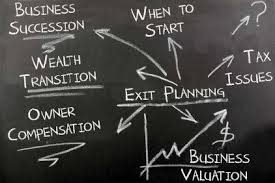COVID-19 Exit Planning Insight: Keep a Journal
 There’s no shortage of information out there right now on how company owners and CEO’s are responding to COVID-19. [By now, leaders have taken steps to survive and fight another day. Most now understand what business will look like for them until restrictions are lifted, and they’re formulating plans to thrive again post-pandemic.] With few companies going to market during this crisis, our insights will focus on exit planning, acquisition opportunities and non-elective sales for a while.
There’s no shortage of information out there right now on how company owners and CEO’s are responding to COVID-19. [By now, leaders have taken steps to survive and fight another day. Most now understand what business will look like for them until restrictions are lifted, and they’re formulating plans to thrive again post-pandemic.] With few companies going to market during this crisis, our insights will focus on exit planning, acquisition opportunities and non-elective sales for a while.
Today we have a simple but powerful suggestion for owners who wish to sell in the next three to four years: Keep a COVID-19 Journal.
Why a COVID-19 Journal
When you sell a business, the buyer’s financial diligence usually focuses on the past three years. Like it or not, what happens during this COVID-19 disruption will generate lots of pointed questions. It’s unavoidable. Your M&A advisor / investment banker will help you tell your unique story, but you’ll need to have the supporting facts and data.
Keeping a COVID-19 journal means tracking and documenting key events, management decisions and business performance data, in real time, during this crisis. Key events and decisions are those that will have a substantial impact on current or future business performance or risk. Decisions should be well documented, including timing, rationale and expected results.
The more data and details you have the better your story can be told. Don’t try to remember it all. Some of this data may not be captured in or stored by your ERP system. For example, you may need to be manually recording weekly RFPs, quoting activity and order backlog.
Examples of Key Events and Decisions:
Financial/Liquidity
- draw-down on the credit line
- renegotiated bank covenants or asset-base
- cancelled all company credit cards
- sold surplus assets to generate cash
- other key cash preservation actions taken
- government subsidies received and how accounted for
Customers
- change in key customer payment terms or collections
- major order cancellations
- downstream verticals shut down and aided by crisis
- customer loss or gain due to or during the crisis
- impact on orders, sales and accounts receivable
Marketing & Sales
- implementation of new remote/online sales strategies
- implementation of new marketing initiatives
- RFP inquiries and quoting activity
Suppliers
- renegotiated payment terms
- changed payment practices
- notified that critical components unavailable
- major order cancellations
- major supply chain interruptions and changes
- renegotiated lease or mortgage payments
- impact on accounts payable
Employees
- salary reductions, job-sharing, furloughs and layoffs (and severance paid)
- major staff redeployments
- organizational restructuring
- new hires/rehires – impact on payroll
Products & Services
- diversified (new product line or service) to generate sales
- decision to stop replenishing certain inventory (to preserve cash)
- major resource shifts
- suspension of a product development initiative
Strategic/Operations
- shifts in target markets, products, services or customers
- major re-positioning or change in business model
- permanent operational changes made
- a new strategic alliance
- acquisition of a distressed competitor
Action Steps
Start your journal today and cover historical events as best you can. Assign someone to take detailed minutes of weekly or daily executive team meetings and compile KPI’s. Schedule time each day to summarize key events, decisions and performance metrics.
One of my clients finds writing this journal to be “therapeutic, amid the chaos”. And he’s looking forward to telling his unique COVID-19 story to prospective acquirers (and their lenders).
As a result of this surprise economic crisis, acquirers may be adding “Evaluate the potential impact of future unpredictable business disruptions” to their acquisition due diligence check lists. We’ll soon find out.
If you are wondering what information to include in your COVID-19 Journal, Exit Strategies Group’s M&A advisors and valuation experts can provide invaluable insights. Don’t hesitate to call if we can help you prepare your journal, make a strategic acquisition, or prepare for a post-pandemic exit.
Previous COVID-19 M&A Updates:








 It was time. After 30 years running their small 25-employee company, Frank and Martha were ready to retire to the Oregon Coast. To their surprise, after a 12-month listing with a business broker, there were just a few interested parties and no offers. Instead of enjoying retirement, Frank and Martha are now a year older and no closer to retirement. For them, preparing to sell was an after-thought.
It was time. After 30 years running their small 25-employee company, Frank and Martha were ready to retire to the Oregon Coast. To their surprise, after a 12-month listing with a business broker, there were just a few interested parties and no offers. Instead of enjoying retirement, Frank and Martha are now a year older and no closer to retirement. For them, preparing to sell was an after-thought.

